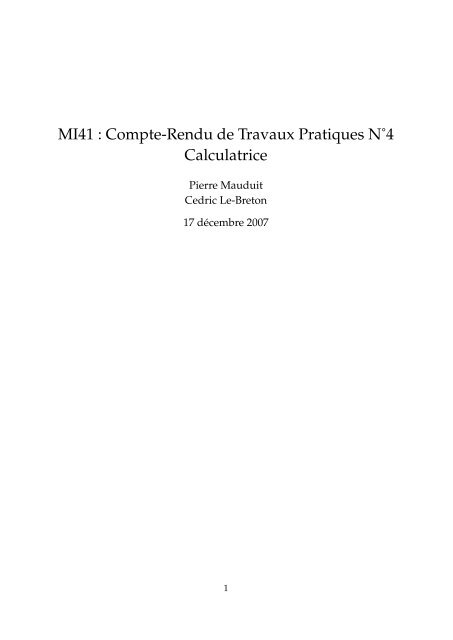MI41 : Compte-Rendu de Travaux Pratiques N˚4 Calculatrice - net
MI41 : Compte-Rendu de Travaux Pratiques N˚4 Calculatrice - net
MI41 : Compte-Rendu de Travaux Pratiques N˚4 Calculatrice - net
You also want an ePaper? Increase the reach of your titles
YUMPU automatically turns print PDFs into web optimized ePapers that Google loves.
<strong>MI41</strong> : <strong>Compte</strong>-<strong>Rendu</strong> <strong>de</strong> <strong>Travaux</strong> <strong>Pratiques</strong> <strong>N˚4</strong><br />
<strong>Calculatrice</strong><br />
Pierre Mauduit<br />
Cedric Le-Breton<br />
17 décembre 2007<br />
1
1 Introduction<br />
Durant cette quatrième séance <strong>de</strong> travaux pratiques, le but est double :<br />
– Etudier une unité entière simplifiée<br />
– Mettre en oeuvre un graphe <strong>de</strong> comman<strong>de</strong><br />
Pour cela, nous allons réaliser une calculatrice, dont les capacités seront limitées à l’opération<br />
+.<br />
2 Le déco<strong>de</strong>ur d’instruction<br />
Le premier composant à concevoir dans cette séance <strong>de</strong> travaux pratiques est le déco<strong>de</strong>ur<br />
d’instruction <strong>de</strong> la calculatrice. Donnons les entrées et les sorties mises en jeu ici :<br />
En entrée :<br />
– Cmd<br />
En sortie :<br />
– Sel<br />
– Sel_E<br />
– Sel_A<br />
– Sel_B<br />
– nload<br />
– Cu<br />
Le co<strong>de</strong> VHDL correspondant à ce composant est donné ci-<strong>de</strong>ssous :<br />
l i b r a r y i e e e ;<br />
// Libs u t i l i s é e s<br />
use i e e e . s t d _ l o g i c _ 1 1 6 4 . a l l ;<br />
use i e e e . std_logic_unsigned . a l l ;<br />
use i e e e . s t d _ l o g i c _ a r i t h . a l l ;<br />
e n t i t y instr_<strong>de</strong>co<strong>de</strong> i s<br />
port (<br />
Cmd : in s t d _ l o g i c _ v e c t o r (5 downto 0 ) ; //mot en entrée<br />
sel , nload , sel_A , sel_B , sel_E : out s t d _ l o g i c ;<br />
Cu : out s t d _ l o g i c _ v e c t o r (1 downto 0)<br />
) ;<br />
end instr_<strong>de</strong>co<strong>de</strong> ;<br />
Les variables évoluant sans arret, nous avons du utiliser un signal dans le but <strong>de</strong> leur<br />
donner une valeur.<br />
2
Sel correspond au premier bit du mot d’entrée, cela permet <strong>de</strong> savoir sur quel registre stocker<br />
le resultat.<br />
Sel_B correspond au <strong>de</strong>uxième bit car il s’agit du registre source 1 et Sel_A correspond<br />
au troisième bit car il s’agit du registre source 2.<br />
Sel_B et Sel_A correspon<strong>de</strong>nt respectivement au <strong>de</strong>uxième et au troisième bit d’entrée, selectionnant<br />
le registre source 1 et source 2.<br />
Cop (co<strong>de</strong> opérateur) permet <strong>de</strong> déterminer la valeur <strong>de</strong> Cu et nload suivant les cas.<br />
a r c h i t e c t u r e a of instr_<strong>de</strong>co<strong>de</strong> i s<br />
s i g n a l cop : s t d _ l o g i c _ v e c t o r (2 downto 0 ) ;<br />
s i g n a l s1 , s2 , d : s t d _ l o g i c ;<br />
begin<br />
process (Cmd)<br />
begin<br />
cop
3 L’Unité <strong>de</strong> comman<strong>de</strong> simplifiées<br />
Donnons tout d’abord le graphe à état <strong>de</strong> l’addition que l’on cherche à implémenter<br />
dans la calculatrice :<br />
Les différents états représentés signifient :<br />
– X0 : affichage<br />
– X1 : chargement 1re valeur<br />
– X2 : changement <strong>de</strong> registre<br />
– X3 : attend l’opérateur<br />
– X4 : chargement <strong>de</strong>uxième valeur et sauvegar<strong>de</strong> <strong>de</strong> l’opérateur<br />
– X5 : choix opération suivante<br />
Le Co<strong>de</strong> VHDL correspondant est donné ci-<strong>de</strong>ssous :<br />
l i b r a r y i e e e ;<br />
use i e e e . s t d _ l o g i c _ 1 1 6 4 . a l l ;<br />
e n t i t y simple_command_unit i s<br />
port (<br />
C , e , p : in s t d _ l o g i c ;<br />
S : out s t d _ l o g i c _ v e c t o r (5 downto 0 ) ;<br />
) ;<br />
end simple_command_unit ;<br />
a r c h i t e c t u r e a of simple_command_unit i s<br />
type s t a t e _ t i s ( X0 , X1 , X2 , X3 , X4 , X5 ) ;<br />
s i g n a l e t a t : s t a t e _ t ;<br />
begin<br />
4
process (C)<br />
v a r i a b l e v : s t d _ l o g i c ;<br />
begin<br />
i f ( C’ event and C= ’1 ’ ) then<br />
case e t a t i s<br />
when X0 => i f ( p= ’1 ’ ) then<br />
e t a t e t a t i f ( e = ’ 1 ’ ) then<br />
e t a t
4 Conclusion<br />
Cette séance <strong>de</strong> travaux pratiques a permis <strong>de</strong> mettre en valeur <strong>de</strong>s aspects plus poussés<br />
du langage VHDL que les aspects <strong>de</strong> base vus dans les séances précé<strong>de</strong>ntes, en réalisant<br />
une calculatrice, objet qui peut paraitre banal, mais qui est finalement loin d’être trivial,<br />
conceptuellement parlant.<br />
6


